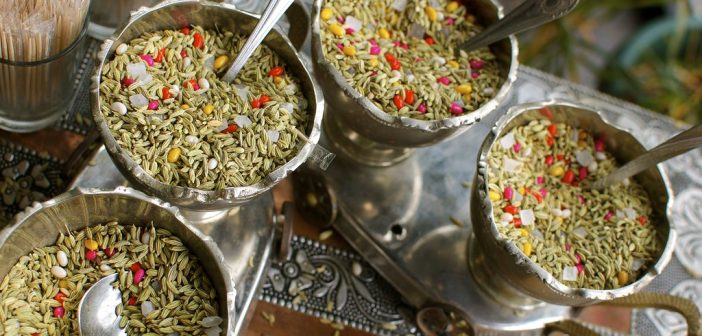The recent case of diners consuming dry ice after it was served in place of a mouth freshener at a Gurugram cafe only exposes the tip of an iceberg. Mouth fresheners are served at most restaurants in India and is a tradition of sorts. Unfortunately, millions of persons consume them daily, oblivious to the health hazards they pose.
In the vibrant tapestry of Indian cuisine, a delightful meal often concludes with a sweet aftertaste and a refreshing mouth freshener. But what if this seemingly innocuous tradition harbored a hidden danger? Mouth fresheners, particularly those left on tables and counters for communal use in restaurants, can become breeding grounds for bacteria and pose a significant health risk.
This article delves into the potential hazards of consuming unhygienically maintained mouth fresheners in Indian restaurants. We’ll explore the types of germs that can lurk on these frequently touched surfaces, the potential health consequences of ingesting them, and alternative, safer practices for post-meal refreshment.
A Breeding Ground for Bacteria
Restaurants, by their very nature, are hubs of human activity. Countless patrons frequent these establishments daily, each leaving behind a trail of germs on surfaces they touch. Unfortunately, mouth freshener containers, often left unguarded on tables and counters, become prime targets for such microbial contamination.
- Transfer of Germs: Every time a person reaches for the container, touches the lid, or scoops out a mint, they transfer bacteria from their hands to the surface. This creates a cumulative effect, with germs multiplying rapidly under favorable conditions.
- Contaminated Ingredients: The mouth fresheners themselves can become breeding grounds for bacteria. If not stored properly, moisture can accumulate in the container, creating a breeding ground for mold and other microbes. Additionally, if the container is refilled without proper cleaning, any residual bacteria from the previous batch can contaminate the new supply.
The Culprits: Common Germs on Mouth Fresheners
A variety of bacteria can thrive on the surfaces of unhygienically maintained mouth fresheners. Some of the most common culprits include:
- Escherichia coli (E. coli): This bacteria can cause a range of gastrointestinal issues, including cramps, diarrhea, and nausea.
- Staphylococcus aureus (Staph): This bacteria can cause skin infections, but more concerningly, some strains are antibiotic-resistant, making them more difficult to treat.
- Hepatitis A virus: This virus can cause liver inflammation, fatigue, and nausea. While transmission through mouth fresheners is less common, it’s a possibility if the container is contaminated with fecal matter.
The Potential Health Risks
Consuming mouth fresheners contaminated with bacteria or viruses can lead to a variety of health problems. The severity of these issues depends on the type and amount of germs ingested, as well as an individual’s overall health. Some potential consequences include:
- Foodborne Illness: This is the most common health risk associated with consuming contaminated mouth fresheners. Symptoms can range from mild stomach upset to severe diarrhea, vomiting, and dehydration.
- Skin Infections: If contaminated mouth fresheners come into contact with open wounds or cuts on the hands, they can cause skin infections.
- Viral Infections: In rare cases, viruses like Hepatitis A can be transmitted through contaminated mouth fresheners.
Children at Higher Risk
It’s important to note that children are especially vulnerable to the health risks associated with unhygienic mouth fresheners. Their developing immune systems are less equipped to fight off infections, and they are more likely to put unwashed hands directly into their mouths.
Safer Alternatives for Post-Meal Freshness
Fortunately, there are several safer alternatives to using communal mouth fresheners in restaurants:
- Individually Packaged Mints: Many restaurants now offer individually wrapped mints or candies, eliminating the risk of contamination from communal containers.
- Mouthwash: Carrying a travel-sized bottle of mouthwash allows for a quick and effective way to freshen breath after a meal.
- Natural Options: Chewing on a clove, cardamom pod, or fennel seed can provide a refreshing and natural alternative to artificial mouth fresheners.
Promoting Hygiene in Restaurants
The responsibility for ensuring the safety of mouth fresheners lies not only with patrons but also with restaurant owners and staff. Here are some ways restaurants can promote better hygiene:
- Regular Cleaning: Containers should be disinfected frequently throughout the day, especially during peak hours.
- Individual Portions: Consider offering small, individual packets of mouth fresheners instead of communal containers.
- Proper Storage: Ensure mouth fresheners are stored in airtight containers to prevent moisture buildup and contamination.
- Staff Training: Train staff on the importance of proper hygiene practices when handling mouth fresheners.
Conclusion
The delightful tradition of offering mouth fresheners after a meal in Indian restaurants shouldn’t come at the cost of compromising hygiene. By being aware of the potential health risks and opting for safer alternatives, both patrons and restaurant owners can ensure a truly refreshing and enjoyable dining experience. Remember, a little caution goes a long way in safeguarding your health and well-being.






